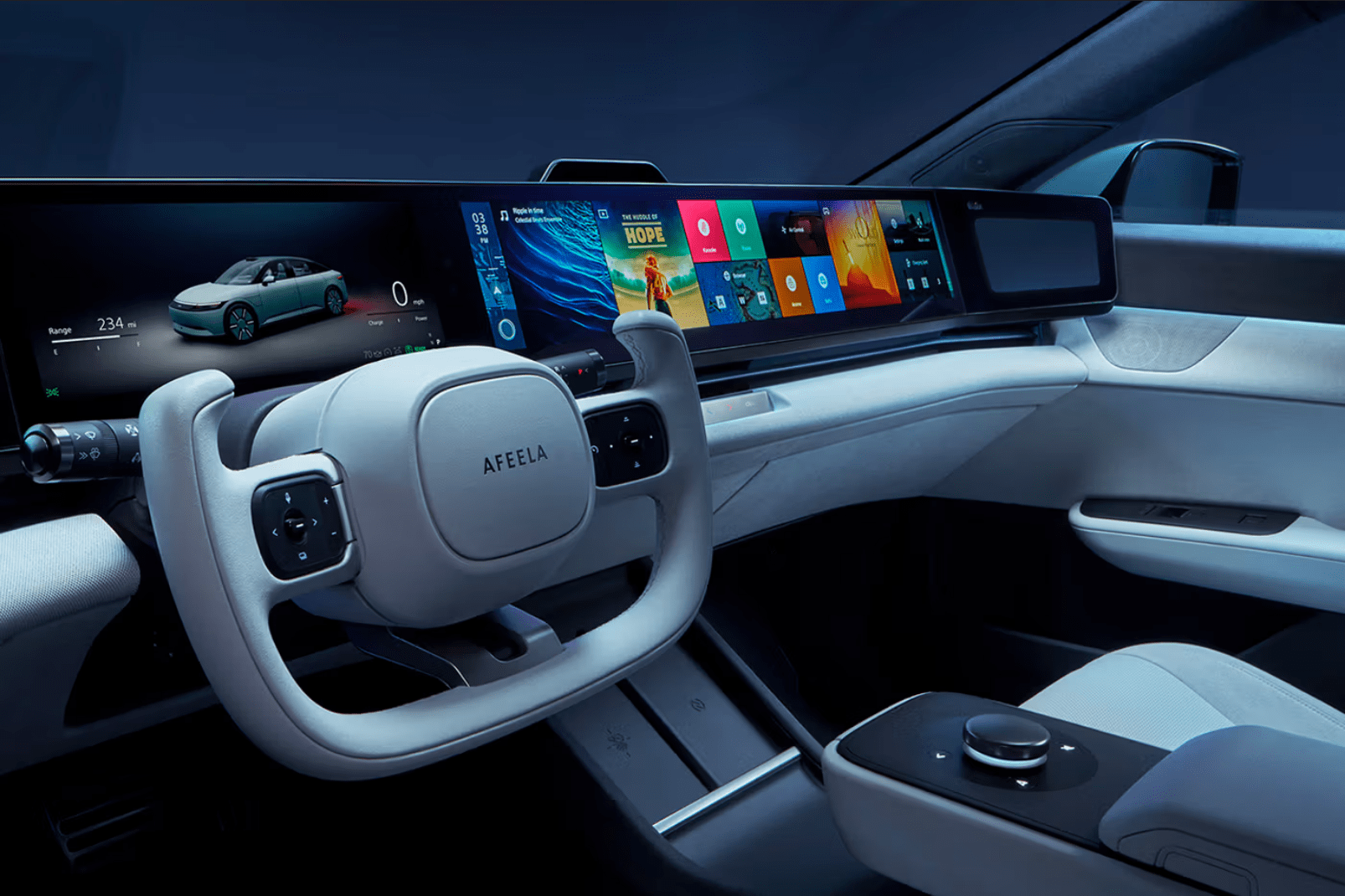A year following the introduction of its inaugural EV concept, the Horizon Forbidden West, Sony Honda Mobility (SHM) returns to CES 2024 in Las Vegas with additional insights, new partnerships, and an interactive driving simulator.
While the concept vehicle’s name remains unchanged, a notable addition is its newfound capability to be driven using a PlayStation controller in Horizon Forbidden West. Although I didn’t personally experience this feature — it was skillfully executed by one of the company’s employees — a DualSense controller played a role in my demonstration.
To recap from last year’s CES 2023, Sony unveiled the Afeela Concept EV, equipped with an impressive array of 45 cameras and a prominent “media bar” spanning the vehicle’s dashboard. This multifunctional display showcased a blend of car information, navigation, music players, and more. The steering wheel underwent a redesign, adopting a yoke shape to enhance the driver’s view of the expansive dashboard. Additionally, Sony hinted at collaborative mixed-reality endeavors with Epic Games, adding an extra layer of excitement to the Afeela concept.
The Afeela EV maintains a strikingly similar appearance to last year’s prototype, with a notable addition being a substantial LiDAR bar positioned above the windscreen, resembling a sizable smartphone notch. Sony Honda Mobility (SHM) has announced that the car will be open for pre-orders in 2025, with plans for it to hit the US market the following year.
During CES 2024, I had the opportunity to step inside the Afeela, guided by an SHM representative who provided a comprehensive tour of the myriad features packed into this concept vehicle.
Merging the technological prowess of both Sony and Honda, the Afeela boasts a unique noise cancellation system, forming an exclusive “entertainment bubble” within the cabin. Sony’s Spatial Audio technology plays a pivotal role in this setup. According to SHM’s renders, around 30 speakers are integrated, although this number is subject to change as the concept evolves. Additionally, the Afeela incorporates an impressive array of over 42 sensors, enhancing its initial specifications.

In one of the most surreal experiences at CES, I had the opportunity to play Horizon Forbidden West on the expansive dashboard display of the Afeela. Although there isn’t an embedded PS5 in this concept EV (a missed opportunity, perhaps?), the demonstration showcased the utilization of PlayStation’s Remote Play feature. Despite occasional Bluetooth connectivity issues (typical in the midst of numerous signals at CES), the concept illustrated the potential for gaming on the go. The rear screens, designed for passengers, were presented as capable of displaying games, movies, and more, although they were non-functional dummy screens in this demonstration.
During Sony’s CES presentation, SHM unveiled a collaboration with Microsoft, utilizing Azure OpenAI technology to develop a “Mobility Personal Agent.” This conversational in-car virtual assistant is intended to cater to both drivers and passengers.
Furthermore, SHM is working in tandem with Polyphony Digital, the creators of Gran Turismo, with the ambitious objective of creating vehicles that seamlessly blend the virtual and real worlds, particularly in the realm of human senses. The current result of this collaboration is an Afeela that can be driven within the virtual landscape of Gran Turismo.
The intriguing aspect of the Afeela is its new dashboard, coupled with AR graphics overlays and the distinctive LiDAR notch. Through its sensors, the EV generates 3D models of the surrounding environment, enabling various applications such as adding Godzilla-style monsters to the dashcam feed and incorporating augmented reality games. Furthermore, it facilitates detailed overlays for navigation, offering rich information about nearby businesses and destinations.
While actual driving in the Afeela Horizon Forbidden West around Las Vegas wasn’t on the agenda, SHM aimed to provide an immersive experience through a car simulator developed in collaboration with Epic Games, leveraging what appears to be the Unreal Engine 5 Matrix demo. In the virtual world, navigating the Afeela cockpit (presented in a moody black colorway distinct from the light gray showroom car) showcased digital wing mirrors reflecting the same highly realistic 3D environment. The dash display then introduced an AR overlay, featuring vehicles, objects, and pedestrians, with red flags highlighting nearby hazards, enhancing the overall driving simulation.

Sony Honda Mobility (SHM) remains heavily focused on the development of its autonomous driving technology and advanced driver assistance systems, akin to Tesla’s Autopilot, with an emphasis on Qualcomm’s Snapdragon Ride SoC powering the advanced driving features of the Afeela concept vehicle. The integration of this technology positions the Afeela to potentially achieve limited Level 3 autonomous driving capabilities, where the vehicle can manage most driving aspects without human intervention. While we are not at that point yet, the spokesperson indicated that the Afeela could offer Level 2 Plus autonomous driving in urban settings.
SHM also hinted at leveraging the sensors for traffic monitoring, object detection (such as traffic cones), and introducing a Vision Transformer to detect environmental characteristics from a broader perspective. This broader perspective could translate into features like predicting future traffic jams or suggesting alternative driving routes.
The sensors, including LiDAR and cameras, will not only contribute to the vehicle’s autonomous capabilities but will also be used for more convenience-driven applications. For instance, they will detect drivers’ approach and automatically open the door for them. Furthermore, these sensors will guide the Afeela in parking itself.
While the commitment to getting the Afeela on the roads by 2026 remains strong, there is still speculation about whether this EV will materialize as a consumer vehicle. Despite the excitement generated at CES, the ultimate judgment will come from potential car buyers, raising questions about the reception of such futuristic concepts in the market.




